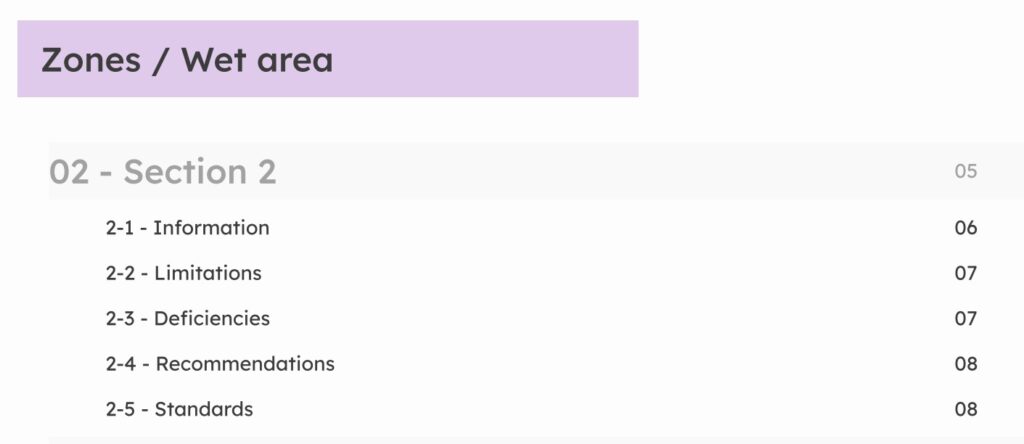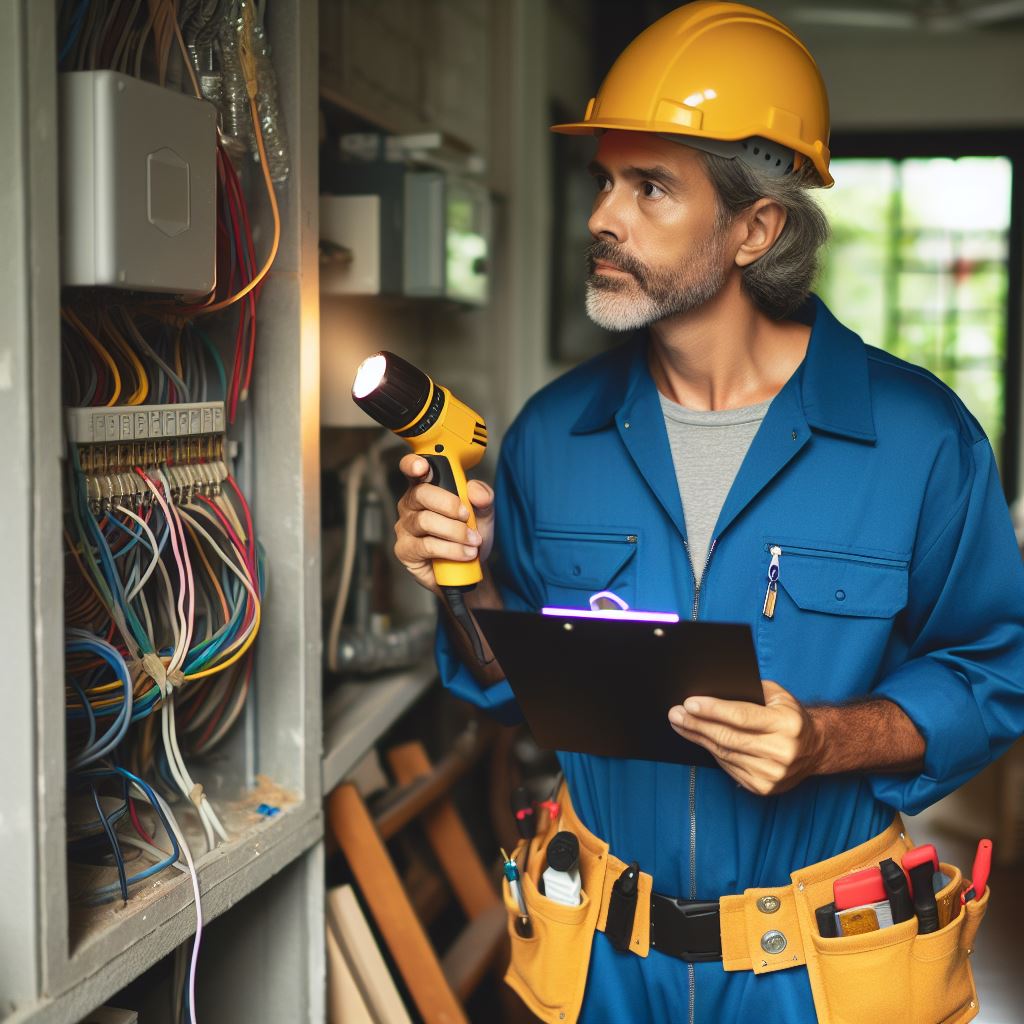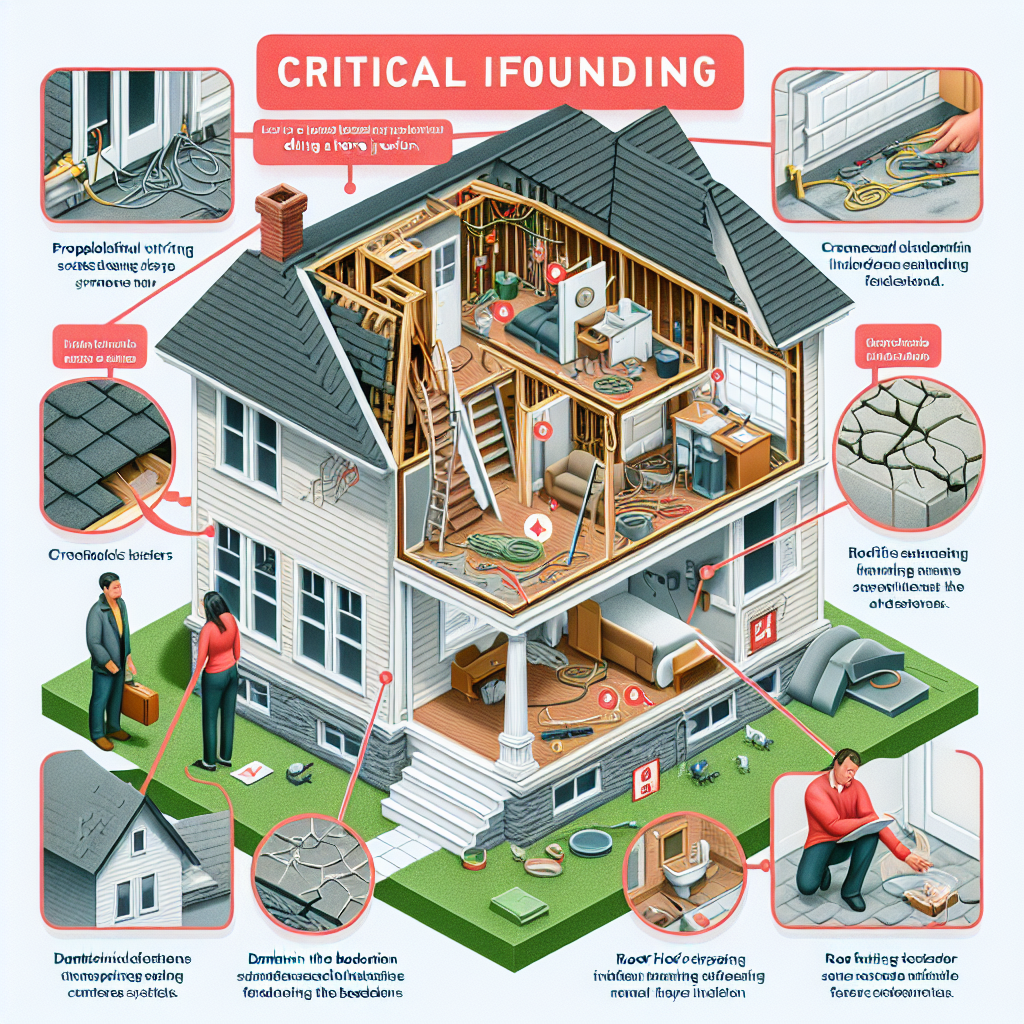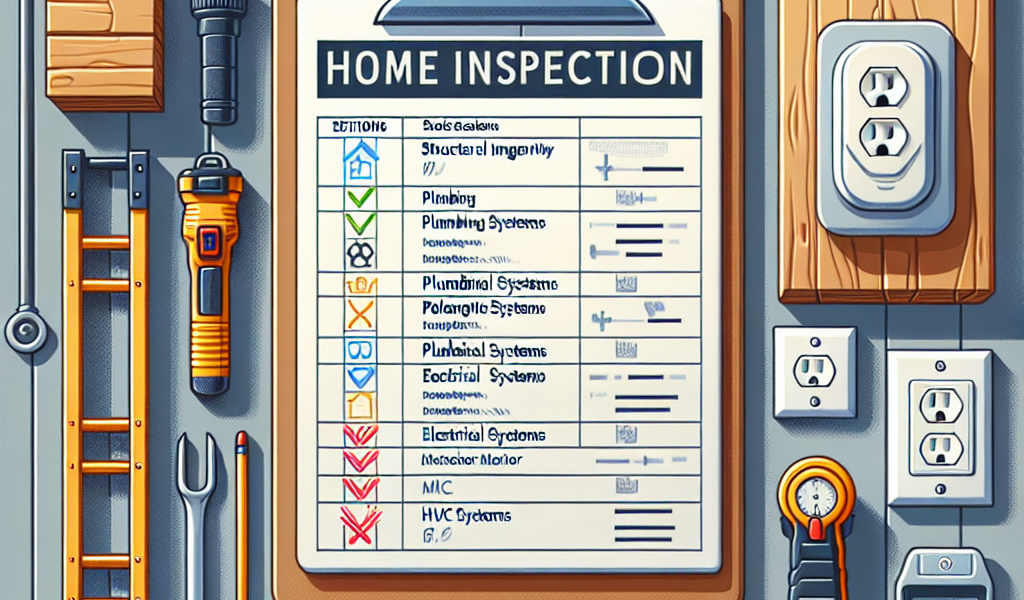Critical Findings: Key Items in the Home Inspection Report
Uncovering the Hidden Risks in Your Home Inspection Report
A home inspection report plays a crucial role in assessing the overall condition of a property before purchase. It provides potential buyers with valuable information about any existing or potential issues within the house. While each home inspection report may vary, there are certain critical findings that should be carefully reviewed and considered. These key items highlight significant concerns that may require immediate attention or further evaluation by specialists. Understanding these critical findings is essential for making an informed decision when buying a home and ensuring the safety and functionality of the property in question.

Structural Integrity: Understanding the Home’s Foundation
A crucial aspect of a home inspection report is assessing the structural integrity, particularly focusing on understanding the home’s foundation. The foundation serves as the building’s base and plays a significant role in providing stability and support. It is essential to thoroughly evaluate this critical component to ensure that it is structurally sound.
One key item to look for during a home inspection is any signs of cracks or movement in the foundation. Cracks can indicate underlying issues with the soil or settling problems. When examining cracks, it is important to consider their size, shape, and location. Small hairline cracks are generally not a cause for concern; however, larger cracks that are wider than 1/8 inch may require further investigation.
Another factor to assess when inspecting the foundation is any signs of water damage or moisture intrusion. Water can seep into foundations through various means such as poor drainage systems or plumbing leaks. Moisture intrusion can lead to deterioration of concrete foundations over time and create favorable conditions for mold growth.
Furthermore, evaluating the slope around the house is crucial in determining potential water-related issues. A positive slope away from the structure helps divert rainwater away from the foundation, preventing pooling and potential damage caused by excessive moisture accumulation.
Inspectors should also check for evidence of previous repairs or modifications made to address foundation issues. Understanding what remedial actions have been taken provides valuable insights into past concerns while allowing inspectors to assess whether these measures were sufficient.
In addition to visual assessments, inspectors often use specialized tools like levels and measuring devices during their evaluation process. These tools help determine if there are any noticeable irregularities in floor slopes or other deviations from levelness that could indicate structural problems related to an unstable foundation.
Moreover, inspectors may need access beneath crawl spaces or basements areas where they can visually inspect footings – supporting structures that transfer loads from walls and columns down into solid ground – for signs of damage or inadequacy in load-bearing capacity. These spaces can also provide valuable information about the presence of any pests, such as termites or rodents, that could further compromise the foundation’s stability.
Once the inspection is complete, a comprehensive report should be provided to clients outlining all findings related to the home’s foundation. This report will include details on any observed issues, recommendations for repairs or further evaluations by specialists if necessary, and estimated costs associated with addressing these concerns.
In conclusion, understanding a home’s foundation is crucial when conducting a thorough structural integrity assessment during a home inspection. Inspectors need to carefully examine cracks, water damage or moisture intrusion, slope around the house, evidence of previous repairs or modifications made to address foundation issues, irregularities in floor slopes using specialized tools like levels and measuring devices while paying attention beneath crawl spaces and basements areas where footings are located. A detailed report summarizing all findings should then be provided to clients for their reference and consideration moving forward. By scrutinizing these key items in the home inspection report relating to structural integrity—specifically focusing on understanding the home’s foundation—potential buyers can make informed decisions regarding property purchase and future maintenance requirements
Electrical Systems: Crucial Components to Inspect
Electrical systems are a crucial component of any home inspection report. They play an essential role in providing power and ensuring the safety of residents. In this section, we will explore key items that should be thoroughly inspected when evaluating the electrical systems in a home.
One of the primary areas to focus on is the electrical panel. This is where all the electricity in a house originates and is distributed throughout various circuits. Inspectors should carefully examine the condition of the panel, looking for any signs of wear or damage. It is also important to check if there are any loose connections or faulty wiring within the panel.

In addition to inspecting the overall condition of the electrical panel, it is essential to assess its capacity. The inspector should verify that it can handle sufficient amperage for all appliances and devices in use within the home. An overloaded electrical panel can lead to overheating and potential fire hazards.
Another critical item to evaluate during an electrical system inspection is grounding and bonding. Grounding provides protection against electric shock by establishing a direct path for current into earth ground if there is an accidental contact with live wires or equipment. Bonding ensures equal voltage potential between metal components such as plumbing fixtures, which helps prevent electric shocks.
Inspectors must check whether proper grounding and bonding have been established according to industry standards, including examining ground rods, conductors, clamps, and other necessary components. Any deficiencies found could potentially pose risks not only to residents but also increase chances of damage due to lightning strikes or power surges.
Proper installation and maintenance of outlets are equally important factors during an electrical system assessment. All outlets should be tested for functionality using appropriate testing equipment like outlet testers that detect open grounds, reverse polarity issues or open neutrals amongst others.
Additionally, inspectors need to pay close attention to possible fire hazards caused by inadequate insulation surrounding light fixtures placed near combustible materials like insulation boards present inside attics or near wooden beams located in basements.

Another crucial aspect of the electrical system inspection is evaluating the condition and integrity of wiring throughout the house. Inspectors should examine both visible and concealed wiring for signs of fraying, cracking, or damage caused by rodents or pests. Wiring that is not up to code or improperly installed may present fire hazards or cause power outages.
Lastly, inspectors must check whether GFCI (ground-fault circuit interrupter) outlets are appropriately installed in areas where water may come into contact with electricity, such as kitchens, bathrooms, laundry rooms, and outdoor spaces. These outlets provide an extra layer of safety by quickly shutting off power when they detect a ground fault or potential electrical shock.
In conclusion, proper evaluation of electrical systems during a home inspection is essential to ensure the safety and functionality of a residence. By focusing on key items like the electrical panel, grounding and bonding components, outlet functionality and placement, wiring condition and integrity along with GFCI outlet installation where necessary; inspectors can identify any potential hazards that require attention before residents move into their new home. It’s important to remember that hiring a qualified electrician if any issues are detected will help address problems promptly while ensuring compliance with all applicable codes and regulations.
Plumbing Issues: Identifying Leaks and Water Damage
A critical component of any home inspection report is the identification of plumbing issues, particularly leaks and water damage. Plumbing problems can be both costly and disruptive if not addressed promptly. This section will discuss the key items in a home inspection report related to plumbing issues, including identifying leaks and water damage.

Firstly, one of the most common plumbing issues that inspectors look for is leaky pipes. Leaks can occur anywhere in a home’s plumbing system, from the main supply line to individual fixtures such as faucets or toilets. Inspectors will thoroughly examine all visible pipes for signs of leakage, such as wet spots or discoloration on walls or ceilings. They may also use specialized tools like moisture meters to detect hidden leaks behind walls or under floors.
Moreover, inspectors pay close attention to the presence of water stains during their evaluation. Water stains are an indication that there has been past or ongoing water damage in a particular area. These stains could appear on ceilings, walls, or even flooring materials like carpets or wood planks. It is crucial for inspectors to determine whether these stains are due to active leaks or have been resolved previously.
Furthermore, inspectors will inspect fixtures such as sinks, showers, bathtubs, and toilets for any signs of leakage. They will check around each fixture carefully for evidence of water pooling at the base or any loose connections that may lead to future leaks. Additionally, they will ensure proper drainage by examining drains for clogs and checking if all fixtures drain quickly without backing up.
In addition to assessing visible signs of leakage and potential sources thereof during their examination process,inspectors often assess the overall condition of a property’s piping system.
This includes evaluating material types (such as copper versus PVC) used throughout the house and determining if there are any observable deficiencies such as corroded pipes.
These assessments help homeowners understand whether their property’s piping infrastructure is prone to long-term issues that may require costly repairs or replacements.

It is worth mentioning that inspectors may also assess the functionality and condition of water supply systems, including pressure regulators and shut-off valves. Pressure regulators help prevent excessive water pressure in a home’s plumbing system, which can lead to leaks or burst pipes. Inspectors will check if these devices are properly installed and functioning correctly. Similarly, they will examine shut-off valves to ensure they can be easily accessed and operated in case of emergencies.
Lastly, it is essential for homeowners to understand that not all plumbing issues are visible during a regular inspection. Some problems may only become apparent after extended periods of use or specific weather conditions. For example, leaking pipes behind walls may only be detected when there is a significant increase in water usage or during heavy rainfall when infiltration becomes evident.
In conclusion, identifying leaks and water damage is crucial when inspecting the plumbing system of a property. Professional home inspectors thoroughly evaluate visible signs such as wet spots on walls or ceilings, water stains indicating past damage, and potential sources like fixtures or piping connections prone to leakage. Additionally, they assess overall pipe condition and functionality of key components like pressure regulators and shut-off valves to provide homeowners with a comprehensive evaluation report regarding their plumbing system’s state. However, it must be acknowledged that some issues may only become apparent under specific circumstances outside the scope of a standard inspection.
Roofing Problems: Spotting Potential Weaknesses
Homeowners know the importance of a solid roof. It protects them from the elements, ensures their safety, and contributes to energy efficiency. That’s why a thorough inspection of the roof is crucial when purchasing or selling a property. This section will explore common roofing problems that inspectors look for and provide tips on how to identify potential weaknesses.
One common issue inspectors encounter is shingle damage. Shingles can become loose, cracked, or even missing due to age, weather conditions, or poor installation. If left unaddressed, this can lead to leaks and water damage within the structure of the home. During an inspection, inspectors carefully examine each shingle for signs of wear and tear.

Another concern with roofs is improper flashing installation. Flashing refers to metal strips that seal joints and prevent water from entering vulnerable areas such as chimneys or skylights. Inadequate flashing can result in water intrusion and subsequent mold growth if not rectified promptly. Inspectors pay close attention to flashing during inspections to ensure it has been correctly installed.
Furthermore, inspectors inspect gutters and downspouts as part of their evaluation process because they play a significant role in maintaining proper drainage around the roof perimeter. Clogged or damaged gutters can cause water buildup on the roof surface leading to rotting wood components and further structural damage over time.
Ventilation issues are also worth noting during a home inspection report analysis since improper ventilation can impact energy efficiency and contribute to moisture problems within an attic space or living area below it. A poorly ventilated attic may experience excessive heat buildup in summer months leading to increased energy costs for cooling purposes while insufficient airflow in winter months could result in condensation forming on surfaces which potentially fosters mold growth if not addressed adequately.
Inspectors also assess chimney condition as part of their roofing examination since brickwork deterioration caused by exposure to harsh weather conditions can pose safety risks. Cracked or crumbling mortar joints, loose bricks, or damaged flashing are all potential concerns that should be addressed promptly to prevent further damage and ensure the chimney’s stability.
In addition to these key issues, inspectors evaluate the roof for signs of moisture intrusion such as water stains on ceilings, dampness in attics, or visible mold growth. These signs may indicate leaks within the roofing system that require immediate attention before more significant problems arise.

Homebuyers and sellers alike can benefit from understanding how to identify potential weaknesses themselves. While not a replacement for a professional inspection, a visual inspection can help homeowners detect obvious red flags before bringing in an expert. Signs of aging shingles like curling edges or granule loss are indicators of imminent replacement needs. Additionally, inspecting attic spaces for any signs of moisture such as dark spots on wood surfaces or musty odors can highlight possible leakage points.
To conclude, evaluating roofing problems during a home inspection is crucial for ensuring structural integrity and preventing costly repairs down the line. Shingle damage, improper flashing installation, gutter issues, ventilation problems, chimney condition evaluation, and identifying signs of moisture intrusion are all essential aspects examined by inspectors. Homeowners should also be aware of some telltale signs themselves to catch glaring issues early on. By being proactive about maintaining their roofs’ health, homeowners can avoid unexpected surprises and protect their investment in the long run
HVAC Systems: Assessing Efficiency and Functionality
A thorough home inspection report is essential for potential home buyers. It provides a detailed assessment of the property and helps identify any issues or problems that may need to be addressed before making a purchase. One critical area that is evaluated during a home inspection is the HVAC system, which stands for heating, ventilation, and air conditioning.
The HVAC system plays a crucial role in maintaining comfort and indoor air quality within a home. It regulates temperature, controls humidity levels, and circulates fresh air throughout the living spaces. As such, it is vital to assess its efficiency and functionality during an inspection.

When evaluating an HVAC system’s efficiency, several key items should be considered. Firstly, the age of the unit is important as older systems tend to be less efficient compared to newer models with advanced technologies. The inspector will typically check the manufacture date on the unit or look for other indicators such as labels or documentation provided by the homeowner.
Another factor that affects efficiency is whether regular maintenance has been performed on the HVAC system. Routine maintenance includes tasks such as cleaning or replacing filters, inspecting electrical connections, lubricating moving parts, and checking refrigerant levels if applicable. A well-maintained system tends to operate more efficiently and have a longer lifespan than one that has been neglected.
Additionally, insulation plays a significant role in optimizing energy usage within a home’s HVAC system. Insufficient insulation can lead to heat loss in winter months or heat gain during summer months due to poor thermal barriers between indoor and outdoor environments. An inspector will examine areas where insulation may be lacking or damaged so that appropriate measures can be taken if necessary.
Functionality is another critical aspect of assessing an HVAC system during an inspection process. The inspector will verify whether all components are operating correctly by testing various functions including heating (if applicable), cooling (if applicable), ventilation fan speed adjustments (if possible), thermostat responsiveness, airflow distribution throughout different zones (if applicable), among others.

Ductwork is also an essential element that should be inspected for functionality. Damaged or poorly installed ducts can result in air leaks, which not only reduce efficiency but also contribute to poor indoor air quality. The inspector will visually inspect accessible portions of the ductwork and evaluate its condition, looking for signs of wear and tear or improper installation.
In addition to efficiency and functionality, safety considerations are crucial when evaluating an HVAC system. This includes checking for carbon monoxide detectors near fuel-burning appliances (such as gas furnaces) and ensuring that exhaust vents are properly installed to prevent the buildup of harmful gases.
Overall, a home inspection report’s assessment of the HVAC system provides valuable insights into its efficiency, functionality, and safety aspects. Potential buyers can use this information to make informed decisions about whether repairs or upgrades are necessary before purchasing a property. By thoroughly evaluating these critical findings in the home inspection report, buyers can ensure they have all the necessary information to negotiate any needed repairs with sellers or plan for future maintenance costs after closing on their new home.
Mold and Moisture Concerns: Protecting Indoor Air Quality
Mold and moisture concerns are critical findings that homeowners should pay close attention to in their home inspection reports. The presence of mold not only poses health risks but can also lead to costly repairs if left unaddressed. Therefore, protecting indoor air quality is essential for the well-being of the occupants and the overall integrity of the property.

When it comes to mold and moisture, prevention is key. It is crucial to identify potential problem areas during a home inspection. These may include areas with excessive humidity, such as basements, bathrooms, or kitchens. Additionally, any signs of water damage or leaks should be thoroughly examined.
One common cause of mold growth is poor ventilation. Inadequate airflow promotes high humidity levels, which create an ideal environment for mold spores to thrive. Inspectors often assess ventilation systems to ensure they are properly functioning and capable of removing excess moisture from the air.
Another area of concern regarding moisture infiltration is windows and doors. Improperly sealed windows or gaps around door frames can allow water penetration during rainstorms or snowmelt. Homeowners should promptly address these issues by resealing or replacing damaged seals to prevent water intrusion.
Furthermore, inspecting plumbing fixtures plays a significant role in preventing mold growth due to leaks or drips that might go unnoticed over time. Pipes hidden behind walls or under sinks should be carefully checked for any signs of leakage.
In addition to visual inspections, inspectors may employ specialized equipment like thermal imaging cameras or moisture meters to detect hidden sources of moisture within walls or ceilings accurately. This technology allows them to identify areas prone to condensation build-up that might otherwise go unnoticed without destructive testing methods.
Once identified, addressing existing mold issues becomes imperative for maintaining good indoor air quality and preventing further damage within the property structure. Depending on the severity of the infestation found during inspection, remediation measures will vary from minor clean-ups involving non-porous surfaces with small patches affected by surface mold, to more extensive interventions requiring the assistance of professionals in cases where mold has infiltrated building materials.

It is worth noting that preventing future mold growth requires regular maintenance and adherence to good practices. This includes promptly fixing any leaks or water intrusions, ensuring proper ventilation and adequate airflow within the property, and keeping humidity levels under control. Homeowners should also be aware of the importance of using exhaust fans when cooking or showering, as these activities can generate excess moisture if not adequately ventilated.
In conclusion, mold and moisture concerns are critical findings highlighted in home inspection reports. They have a direct impact on indoor air quality and require careful attention from homeowners. By identifying potential problem areas during inspections, taking preventive measures against excessive moisture infiltration, promptly addressing existing issues through remediation techniques when necessary, and adopting good maintenance practices afterwards, homeowners can protect both their health and their property investment from the damaging effects of mold growth.
Safety Hazards: Uncovering Potential Risks in the Home
When it comes to buying a new home, the safety and well-being of your family should be at the forefront of your mind. That’s why a thorough home inspection is essential in uncovering potential safety hazards that may be lurking within the property. In this section, we will discuss some critical findings that you should pay attention to in the home inspection report.
One common safety hazard found in homes is electrical issues. Faulty wiring or outdated electrical systems can lead to electrical fires and electrocution risks. The home inspector will examine the condition of the wiring, check for exposed wires, and ensure that all outlets are properly grounded. It is crucial to address any electrical issues promptly to minimize these risks.
Another significant concern when it comes to safety hazards is plumbing problems. Leaking pipes can not only cause water damage but also create an environment conducive to mold growth, which can pose health risks for you and your family. A competent home inspector will thoroughly examine all plumbing fixtures, including toilets, sinks, showers, and drains, checking for leaks or signs of water damage.
Structural integrity is also vital for ensuring your safety within a home. Issues such as foundation cracks or unstable stairs can pose severe risks if left unaddressed. During the inspection process, the inspector will assess the condition of the foundation by examining visible cracks or signs of settling. They will also inspect staircases for loose handrails or uneven steps that could potentially cause accidents.
Additionally, one aspect often overlooked during inspections but equally important regarding safety hazards is ventilation systems in a house. Poor indoor air quality due to inadequate ventilation can lead to respiratory problems and allergies over time. A professional inspector will evaluate existing ventilation systems such as exhaust fans in bathrooms and kitchens along with air vents throughout the house.
Furthermore, fire hazards should always be taken seriously when it comes to maintaining a safe living environment within a property. The presence and proper functioning of smoke detectors are essential components assessed during the inspection. The inspector will test existing smoke detectors and determine if additional ones are required, ensuring that they are installed in the correct locations throughout the home.
Finally, it is crucial to consider potential safety hazards outside of the property as well. An experienced home inspector will examine outdoor areas such as decks, balconies, and stairs for any signs of deterioration or structural issues. It’s important to address these concerns promptly as they could lead to accidents or injuries when accessing outdoor spaces.
In conclusion, a comprehensive home inspection report can reveal critical findings related to safety hazards within a property. From electrical issues and plumbing problems to structural integrity and ventilation systems, each aspect plays a vital role in maintaining your family’s safety. Additionally, fire hazards should never be overlooked, along with evaluating outdoor areas for potential risks. By carefully reviewing these key items identified in the home inspection report and addressing them appropriately before purchasing a new house, you can ensure a safe living environment for you and your loved ones.
Pest Infestations: Detecting Signs of Unwanted Guests

A home inspection report is a crucial document that provides detailed information about the condition of a property. It is essential for both buyers and sellers to understand the key items in the report, as it can greatly influence their decision-making process. One critical aspect that should be thoroughly examined is pest infestations. Identifying signs of unwanted guests in a property can save homeowners from potential financial burdens and health hazards.
Pests such as rodents, termites, cockroaches, and ants are common invaders found in homes worldwide. Their presence can lead to structural damage, contamination of food sources, and spread of diseases. Consequently, detecting signs of pest infestations early on can prevent significant problems down the line.
One of the most evident indications of pests is droppings or feces left behind by rodents or insects. The size and shape of these droppings vary depending on the type of pest present in the house. For instance, rodent droppings tend to be cylindrical with pointed ends while insect feces may resemble tiny black specks or powdery residue.
Another obvious sign is damaged wood or gnaw marks caused by termites or rodents respectively. Termites feed on cellulose-rich materials like wood, causing hollowing out within structures which weakens them over time. Similarly, rodents have continuously growing incisors that drive them to gnaw on various objects including wooden beams and electrical wires.
Unpleasant odors emanating from hidden areas such as attics or crawl spaces could also indicate a pest problem. Rodents often leave behind urine trails which emit a strong ammonia-like smell when they accumulate over time.
In addition to physical evidence, unusual sounds coming from walls or ceilings might suggest an infestation issue requiring attention. Rats scurrying through voids create scratching noises while termite infested wood may produce clicking sounds due to tunneling activity within its structure.
Furthermore, visual sightings play a significant role in identifying pests. For instance, cockroaches are nocturnal insects that prefer to hide during daylight hours but may be spotted scuttling across the kitchen floor at night. Similarly, ants can often be seen in long trails leading from their nest to a food source.
Apart from these overt signs of pest infestations, it is crucial to pay attention to less apparent indicators as well. Stains or discoloration on walls and ceilings could suggest moisture problems caused by leaks or water damage – conditions which attract pests like termites and mold. Additionally, damaged electrical wiring might indicate rodent activity seeking gnawing material or shelter.
It is important for homeowners not only to detect these signs but also understand the severity of infestation indicated by them. Some minor issues may be resolved through simple measures such as sealing entry points or using insecticides; however, significant infestations usually require professional intervention.
In conclusion, a thorough examination of a home inspection report’s section on pest infestations is vital when buying or selling a property. Recognizing the signs of unwanted guests allows homeowners to take appropriate action early on before potential financial and health risks escalate further. From droppings and damaged wood to odors and sounds, various indicators can help identify different types of pests lurking within a house’s confines. By being aware of these critical findings, individuals can make informed decisions about how best to deal with any existing pest-related issues in their homes while ensuring the overall safety and well-being of their families.
Fire Hazards: Ensuring Adequate Fire Safety Measures
A home inspection report is a crucial document that provides detailed information about the condition of a property. It is essential for both buyers and sellers to be aware of the critical findings mentioned in this report. In this section, we will focus on fire hazards and the importance of ensuring adequate fire safety measures in your home.
One of the primary concerns when it comes to fire hazards is faulty electrical wiring. This can lead to short circuits or electrical fires, posing a significant risk to life and property. The home inspection report will highlight any issues with the wiring system, such as outdated or poorly maintained wiring, overloaded circuits, or improperly installed outlets.
Another common fire hazard found in homes is inadequate smoke detector placement or malfunctioning smoke detectors. Smoke detectors are crucial for early detection and alerting occupants during a fire emergency. The inspection report should mention whether there are enough smoke detectors installed throughout the property and if they are functioning properly.
Additionally, an examination of heating appliances like furnaces, boilers, and chimneys will be conducted during the home inspection process. These appliances can pose serious fire hazards if not properly maintained or installed incorrectly. The inspector will assess their condition, checking for any signs of damage or lack of maintenance that may increase the risk of a fire occurring.
Furthermore, flammable materials stored improperly can contribute significantly to house fires. It’s important to ensure that combustible items such as gasoline cans, cleaning supplies, paints, and other chemicals are stored safely away from potential heat sources like water heaters or furnaces. The inspection report should note any instances where these materials are not appropriately stored.
The presence and functionality of fire extinguishers will also be assessed during the inspection process. Fire extinguishers play a crucial role in containing small fires before they escalate into something more significant. Therefore it’s vital to have easily accessible extinguishers throughout your property which have been regularly serviced according to manufacturer recommendations.
In older homes especially, insulation material may contain asbestos, a highly hazardous substance known to cause respiratory problems and increase the risk of fire spread. The inspection report should mention any concerns regarding insulation materials and advise on the necessary steps to address potential risks associated with asbestos.
Finally, proper exit routes and clear access to exits are essential for fire safety. The inspection report will indicate whether there are unobstructed paths leading to exits and if emergency escape windows meet current safety standards. It is crucial for homeowners to ensure that all exit routes remain easily accessible in case of an emergency.
In conclusion, fire hazards can be potentially life-threatening, making it crucial to pay close attention to them during a home inspection. Faulty electrical wiring, inadequate smoke detectors, poorly maintained heating appliances, improper storage of flammable materials, lack of functioning fire extinguishers or improper insulation materials can significantly increase the risk of a house fire. By addressing these critical findings identified in the home inspection report promptly and taking appropriate action where necessary, homeowners can ensure adequate fire safety measures are in place within their property.
Insulation Evaluation: Assessing Energy Efficiency Levels
Insulation plays a crucial role in maintaining energy efficiency levels within a home. As part of the home inspection process, evaluating insulation becomes an essential task to identify any potential issues or areas for improvement. This article will discuss key items that are included in the home inspection report when assessing insulation and its impact on energy efficiency.
One of the primary elements examined during an insulation evaluation is the type of insulation used in the property. Common types include fiberglass, cellulose, and spray foam. Each material has its own unique properties and performance characteristics. The inspector examines whether these materials are correctly installed throughout various parts of the house, such as walls, ceilings, floors, attics, and crawlspaces.
The condition of the existing insulation is another critical aspect considered during evaluation. Over time, insulation can deteriorate or become damaged due to factors like moisture intrusion or pests’ presence. These damages can significantly compromise its effectiveness in providing adequate thermal resistance. Therefore, inspectors carefully inspect for signs of damage or decay that might warrant repairs or replacement.
In addition to material type and condition assessment, it’s important to evaluate if there are sufficient amounts of insulation present throughout all areas being inspected. Proper installation requires meeting specific thickness requirements based on regional climate conditions and building codes.
To determine if proper thickness levels have been achieved, inspectors measure R-value – a rating system indicating thermal resistance capacity – which varies depending on different regions’ climates zones across the country. For example: colder regions typically require higher R-values compared to warmer ones since they need greater resistance against heat loss through conduction.
Moreover, inspectors also assess how well insulated areas are sealed against air leaks by checking for gaps or cracks around windowsills frames doors penetrations etcetera those serve as potential pathways where conditioned air could escape from indoors while allowing unwanted outdoor air infiltration affecting energy efficiency thus increasing heating cooling costs
Furthermore inadequate sealing may also contribute negative effects moisture accumulation inside wall cavities causing mold growth other structural problems in some cases.
In evaluating insulation, the home inspector may also consider the presence of vapor barriers or moisture control measures. Vapor barriers prevent moisture from entering through walls and ceilings, reducing the risk of condensation and subsequent damage. Inspectors inspect whether these barriers are properly installed to ensure their effectiveness in maintaining a dry and comfortable living environment.
During the evaluation process, inspectors may use thermal imaging cameras to identify areas with inadequate insulation or air leakage. These tools can help visualize temperature differences that indicate poor insulation performance or hidden issues that aren’t easily visible to the naked eye.
In conclusion, assessing insulation during a home inspection is crucial for determining energy efficiency levels within a property. Key items examined include type, condition, thickness, sealing against air leaks, vapor barriers’ presence and quality, as well as utilizing advanced technologies such as thermal imaging cameras when necessary. Identifying potential deficiencies allows homeowners to make informed decisions about repairs or upgrades necessary for improving their homes’ overall energy efficiency while maximizing comfort and cost savings in the long run.
Window and Door Defects: Addressing Drafts and Security Issues
Windows and doors are essential components of any home, providing both functionality and aesthetic appeal. However, over time, these features can develop defects that compromise their performance and security. This section aims to highlight some critical findings related to window and door defects found in home inspection reports, with a focus on addressing drafts and security issues.
One common issue identified in the inspection reports is the presence of drafts around windows and doors. Drafts occur when there are gaps or cracks that allow air infiltration from the outside into the interior space. Not only do drafts lead to discomfort by making rooms feel colder during winter months or hotter during summer months, but they also increase energy costs as heating or cooling systems have to work harder to maintain desired temperatures.
To address this problem effectively, homeowners should first identify the source of drafts by carefully inspecting areas around windows and doors for visible cracks or gaps. Common areas where drafts are often found include window frames, door frames, weatherstripping, and caulking joints. Once identified, appropriate measures such as resealing with caulk or replacing damaged weatherstripping can be taken to mitigate drafts.
Moreover, another crucial aspect highlighted in inspection reports is related to security issues associated with windows and doors. Security breaches through vulnerable entry points pose serious risks for homeowners’ safety as well as their belongings. Weak locks or poorly installed hardware make it easier for intruders to break into homes undetected.
To improve security levels significantly, it is recommended that homeowners consider reinforcing existing door frames using metal plates or upgrading locks with more robust options like deadbolts or electronic keyless entry systems. For windows on ground floors or accessible locations prone to break-ins attempts such as basement windows at street level—adding laminated glass panels can act as an effective deterrent against forced entries while allowing natural light penetration.
In addition to addressing specific concerns raised within home inspection reports regarding draftiness and potential security vulnerabilities of windows and doors; periodic maintenance is crucial to prevent further deterioration. Regular inspection and cleaning of windows and doors are essential to ensure their proper functioning.
Cleaning should involve removing dirt, dust, or debris from frames, tracks, and hardware components. This not only helps maintain a neat appearance but also prevents the accumulation of particles that may impede smooth operation or cause damage over time.
Furthermore, lubricating moving parts like hinges, rollers, and locks with appropriate oils or silicone sprays enhances performance by reducing friction and preventing premature wear. Periodic checks for loose screws or damaged seals can also contribute to maintaining optimal window and door conditions.
In conclusion, home inspection reports often highlight critical findings related to window and door defects that require immediate attention. Drafts around windows and doors impact energy efficiency while compromising comfort levels within the home. Security issues associated with vulnerable entry points pose serious risks to homeowners’ safety as well as property security.
Addressing these concerns involves identifying sources of drafts through careful inspections, sealing gaps or cracks using suitable materials like caulk or weatherstripping replacement. Additionally improving security measures such as reinforcing door frames with metal plates and upgrading locks contributes significantly towards ensuring the safety of occupants.
Lastly periodic maintenance routines including regular cleaning, lubrication of moving parts along with checking for loose screws or damaged seals help in preserving the longevity of windows and doors while keeping them in optimal working condition.
Exterior Maintenance Needs: Evaluating Curb Appeal and Upkeep
When it comes to home inspections, one of the most critical aspects is evaluating the exterior maintenance needs of a property. This involves assessing the overall curb appeal and upkeep of the house, as well as identifying any potential issues that may require attention. By examining these key items in the home inspection report, homeowners can gain valuable insights into areas that need improvement or maintenance.
One of the first things a home inspector looks for when evaluating curb appeal is the condition of the exterior walls. Cracks or gaps in stucco, wood rot on siding, or peeling paint are all signs of neglect and can lead to more serious structural problems if left unaddressed. These issues not only compromise the aesthetic value but also affect energy efficiency by allowing air leakage.
Another important aspect to consider is the condition of doors and windows. Inspectors check for proper operation, weatherstripping, and caulking around frames. Any gaps or deterioration in these areas can result in drafts, water intrusion during heavy rainfalls, increased utility bills due to loss of heating or cooling capacity.
Additionally, an evaluation of roofing materials is crucial in determining its lifespan and integrity. The inspector will look for missing shingles or tiles, damaged flashing around chimneys or vents which could cause leaks inside your home if ignored. It’s important to address any roofing issues promptly before they turn into major water damage problems down ceilings and walls.
A thorough examination should also include an assessment of gutters and downspouts’ functionality; these are essential components for diverting rainwater away from foundations to prevent flooding hazards such as basement dampness/mold growths over time – both detrimental health risks associated with poor indoor air quality while impacting overall structural stability significantly if not remedied timely.
Inspectors pay close attention to landscaping elements such as grading (slope) around foundations since improper drainage patterns contribute directly towards moisture infiltration into basements, crawl spaces causing issues like cracks on concrete surfaces or foundation shifts. Besides, they will note any overgrown trees or shrubs that may pose risks to the house by either touching roof structures (causing damage) or blocking natural light sources (reducing overall property appeal).
Lastly, an evaluation of outdoor structures and amenities is essential for a complete assessment of exterior maintenance needs. This includes inspecting decks, patios, fences, and swimming pools for signs of decay or damage. Rotting wood on a deck can be hazardous if not addressed promptly due to potential collapse when in use; damaged pool equipment poses safety concerns while deteriorating fencing detracts from both security levels as well as aesthetics.
In conclusion, evaluating the exterior maintenance needs during a home inspection is crucial for identifying areas that require attention and improvement. From assessing the condition of walls and roofing materials to examining doors/windows functionality and landscaping elements such as grading or drainage patterns – these findings provide homeowners with valuable insights into necessary repairs or upkeep tasks required to ensure a safe and appealing living environment. By addressing these critical items identified in the inspection report promptly, homeowners can protect their investment while enhancing their quality of life within their homes
Foundation Settlement or Cracks : Discover Damages that may cost you a lot in future
When it comes to buying a new home, one of the most critical aspects is ensuring its structural integrity. A thorough inspection of the property is necessary to identify any potential issues that may arise and cause significant damage down the line. One such issue that often goes unnoticed but can have severe consequences is foundation settlement or cracks.
Foundation settlement refers to when a home’s foundation sinks or moves from its original position due to various factors, such as soil conditions, poor construction, or water damage. This movement can lead to cracks forming in the foundation walls, compromising its stability and potentially causing other structural problems throughout the house.
Identifying these issues early on during a home inspection is crucial because they can become increasingly difficult and expensive to repair over time. Moreover, if left unaddressed, foundation settlement can even affect a property’s resale value and make it more challenging for homeowners to secure loans or insurance coverage in the future.
During a comprehensive home inspection, an inspector will thoroughly examine the property’s foundation for any signs of settlement or cracks. They will assess both interior and exterior areas of the foundation walls for visible damages that indicate movement has occurred. These damages may include diagonal cracks wider than 1/4 inch at corners of windows or doors; stair-step cracking along mortar joints; bulging walls; uneven floors; gaps between floors and baseboards; sticking doors/windows; or separation between walls and ceilings.
In addition to visual inspections, specialized tools like laser levels are often used by inspectors to measure any differential movement across different parts of the foundation accurately. By comparing measurements taken at various points within each room, they can determine whether there has been any significant shifting or settling present.
Once identified during an inspection report, it is important not only to understand what these findings mean but also their potential implications for homeownership moving forward. Foundation settlement doesn’t always mean the home is on the verge of collapsing, but it does indicate that steps need to be taken to stabilize and repair the foundation.
Depending on the severity of settlement or cracks, various repair methods can be employed. These may include underpinning techniques like helical piers or push piers to support and lift the foundation back into its original position, or slabjacking for concrete slab foundations. It is essential to consult with a professional structural engineer or foundation contractor who can assess the situation accurately and recommend appropriate remediation measures.
It’s worth noting that not all homes will have significant foundation issues requiring immediate attention. Some minor settlement cracks might only require regular monitoring rather than invasive repairs. Nonetheless, having a clear understanding of your home’s condition will enable you as a homeowner to make informed decisions regarding necessary maintenance, repairs, and potential negotiations during real estate transactions.
In conclusion, foundation settlement or cracks should never be overlooked during a home inspection. Recognizing these critical findings early on can help homeowners avoid future headaches and financial burdens associated with severe structural damage. By working closely with professionals in assessing any issues found within your property’s foundation walls, you’ll be taking proactive steps towards ensuring long-term stability and peace of mind in your new home investment.
Drainage System Assessment : How Drainage can affect your property?
A crucial aspect of a home inspection report is the assessment of the drainage system. Many homeowners overlook the importance of proper drainage, but it can have a significant impact on the overall condition and value of a property. In this section, we will explore how drainage can affect your property and discuss key findings that may be included in a home inspection report.
Effective drainage is essential for maintaining a dry and structurally sound property. Improper or inadequate drainage can lead to various problems such as water damage, foundation issues, and mold growth. When water is not properly directed away from the house, it can seep into basements or crawl spaces, causing moisture problems that can compromise the integrity of the structure.
One critical finding in a home inspection report related to drainage is an evaluation of gutters and downspouts. Gutters play a vital role in collecting rainwater from the roof and directing it away from the house. If gutters are damaged or clogged with debris, they cannot effectively perform their function, leading to potential water damage issues. A thorough inspection will assess whether gutters are properly installed, free from cracks or rusting, and clear of any blockages.
In addition to gutters, downspouts also need careful examination during an inspection. Downspouts should extend at least six feet away from the foundation to ensure water does not pool near the house’s perimeter. The inspector will evaluate whether downspouts are securely attached to both gutters and drainpipes while also checking for any signs of leaks or damage.
Another important aspect related to drainage assessment is grading around your property. The ground surrounding your home should be sloped away from its foundation at approximately 1 inch per foot for optimal draining efficiency. This helps prevent rainwater from pooling against exterior walls and potentially infiltrating basements or crawl spaces.
During an inspection, an inspector may use specialized tools such as levels or laser devices to measure slope accuracy accurately. They will also look for signs of soil erosion, improper grading, or areas where water seems to accumulate. These findings are crucial because they can indicate potential issues that need immediate attention to avoid further damage.
A home inspection report may also highlight the condition of the sump pump and its functionality. A sump pump is commonly found in properties with basements or crawl spaces below ground level. It helps prevent flooding by pumping out excess water from these areas. The inspector will inspect the sump pump’s overall condition, test its operation if possible, and ensure it discharges water away from the foundation adequately.
Lastly, a thorough drainage assessment should include an examination of exterior drain systems such as French drains or perimeter drains. These systems are designed to collect and divert groundwater away from your property. Inspectors will check for proper installation, any signs of clogging or blockages, and ensure that discharge outlets are clear and functioning correctly.
In conclusion, understanding how drainage can affect your property is essential for maintaining a dry and structurally sound home. An evaluation of gutters, downspouts, grading around your property, sump pumps, and exterior drain systems provides valuable information about potential issues related to drainage in a home inspection report. By addressing these critical findings promptly, homeowners can prevent water damage problems that may significantly impact their property’s value and overall well-being.
Environmental Factors : Evaluate Environmental Condition for long term impact on health of residents
A comprehensive home inspection report is an essential document that provides a detailed analysis of the property’s condition. This report covers various aspects, including structural components, electrical systems, plumbing systems, and much more. However, one crucial section that cannot be overlooked is the evaluation of environmental factors.
When assessing a property for potential health risks to its residents, it is essential to consider environmental conditions such as air quality, water quality, and presence of hazardous materials. These factors can have long-term impacts on the well-being of individuals living in the house.
One key aspect to evaluate in this section is air quality. The inspector will examine if there are any signs of poor indoor air quality which could be caused by issues like mold or mildew growth or inadequate ventilation. Mold and mildew not only contribute to unpleasant odors but can also lead to respiratory problems and allergic reactions among occupants.
The presence of asbestos is another important consideration when evaluating environmental factors. Asbestos was widely used in construction materials before its harmful effects were discovered. Inhalation of asbestos fibers can lead to severe respiratory diseases such as mesothelioma and lung cancer. A thorough inspection should identify any areas where asbestos may be present so that proper mitigation measures can be taken.
Furthermore, it is necessary to assess the water quality within the property. Inspectors will test samples from various sources like faucets and showers for contaminants such as bacteria or excessive levels of minerals like lead or arsenic. Contaminated water poses serious health risks if consumed or used for daily activities like bathing or cooking.
Lead-based paint should also be considered when conducting a home inspection regarding environmental factors since it was widely used until 1978 when its dangers became well-known. Children are particularly vulnerable to lead exposure due to their developmental stage; ingestion or inhalation of lead particles can cause irreversible damage affecting their cognitive abilities and overall development.
Radon gas is another significant concern when evaluating a property’s environmental condition. Radon is a naturally occurring radioactive gas that can seep into homes through cracks in the foundation or gaps in walls and floors. Long-term exposure to elevated levels of radon increases the risk of developing lung cancer.
In addition to these specific environmental factors, inspectors will also evaluate general safety measures within the property. This may include checking for functional smoke detectors, carbon monoxide detectors, and fire extinguishers. These safety features are crucial in ensuring the well-being and protection of residents from potential hazards.
To conclude, evaluating environmental factors during a home inspection is critical for identifying potential health risks associated with living in the property. The air quality should be assessed to determine if there are any signs of mold growth or poor ventilation that could affect respiratory health. Asbestos presence should also be investigated due to its harmful effects on lungs when exposed. Water quality testing ensures that occupants have access to clean and safe water sources free from contaminants like bacteria or excessive minerals such as lead or arsenic. Furthermore, considerations regarding lead-based paint and radon gas exposure should not be overlooked due to their long-term health impacts on individuals residing in the house. Finally, inspecting general safety measures such as smoke detectors and fire extinguishers ensures the overall safety of residents against potential hazards present within the property’s environment.In conclusion, critical findings refer to key items identified in a home inspection report. These are issues or concerns that require immediate attention due to safety hazards, structural problems, or potential costly repairs. The purpose of identifying critical findings is to ensure that the homeowner is aware of any significant issues with the property and can take necessary actions to address them promptly.




